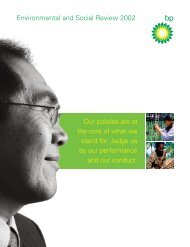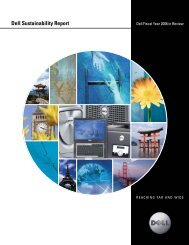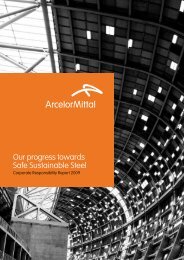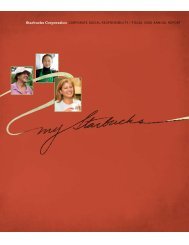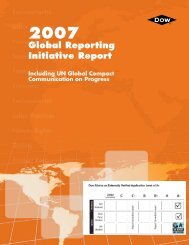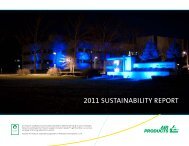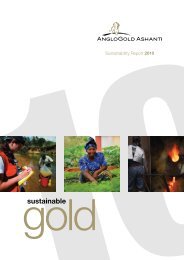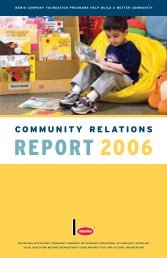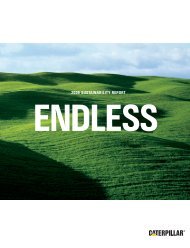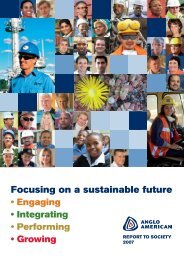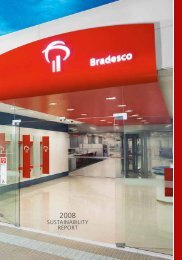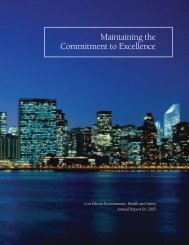SUSTAINABLE STORE DESIGNFor several years, <strong>Starbucks</strong> has been working with <strong>the</strong>U.S. Green Building Council (USGBC) to develop LEED(Leadership in Energy and Environmental Design) standardsand a scoring system specifically for <strong>the</strong> retail sector. Ourvision is that <strong>the</strong> retail-specific scoring system can be usedto LEED-certify a prototype of a <strong>Starbucks</strong> store, and that a“volume-build” criteria will also be developed. This will allowus to build future stores consistent with <strong>the</strong> prototype moduleand <strong>the</strong> LEED criteria.In <strong>the</strong> meantime, in 2005 we designed and built our first storein accordance with LEED Commercial Interior standards.The store is located in <strong>the</strong> Civic Center in Hillsboro, Oregon.We applied for LEED Gold* certification from <strong>the</strong> USGBCin 2006. At <strong>the</strong> time of this printing, we had not receivedfinal certification from <strong>the</strong> USGBC.Although this will be <strong>Starbucks</strong> first LEED-certified store,<strong>the</strong> components that make up this store are very similarto <strong>the</strong> company’s existing stores. This reflects our ongoingcommitment to incorporate <strong>the</strong> use of energy-efficientlighting, paints with reduced toxic chemicals andsustainable wood products that are Forest StewardshipCouncil (FSC) certified.* Different levels of green building certification (certified, silver, gold,platinum) are awarded based on <strong>the</strong> total credits earned in each ofseveral categories: site, energy, material and resources, indoorenvironmental quality and water.<strong>Starbucks</strong> Hillsboro, Oregon store was built in accordance with LEED CommercialInterior standards.Environmental Measures in Our Store Design1 Cabinetry made from 90 percent post-industrial material,with no added formaldehyde2 Efficient lights that use less energy3 Paints with lower amounts of volatile organic chemicals4 Eco-Terr ® flooring tiles made from 70 percent post-consumerrecycled content, 10 percent post-industrial content5 Store designed to capture available natural daylightStriving to Buy, Selland Use EnvironmentallyFriendly ProductsIn 2001, <strong>Starbucks</strong> developed coffee buying guidelines (whichhave evolved into C.A.F.E. Practices) that changed ourpurchasing practices by giving higher priority to suppliers whoproduce coffee in a sustainable manner. (See pages 18-22) Butour commitment to buy, sell and use environmentally friendlyproducts extends well beyond our coffee. For example, weare making environmental improvements to our paper <strong>cup</strong>s,designing more sustainable packaging and engaging witho<strong>the</strong>r paper buyers to develop guidelines for paper purchasing.Paper Working GroupIn 2005, <strong>Starbucks</strong> continued to participate in <strong>the</strong> PaperWorking Group (PWG), a group of 11 large paper buyersled by <strong>the</strong> nonprofit organization Metafore. As a foundingparticipant of <strong>the</strong> PWG, <strong>Starbucks</strong> is working collaborativelyto develop and implement a procurement tool to help paperbuyers evaluate <strong>the</strong> environmental performance of paper(beyond recycled and unbleached content). Over <strong>the</strong> lastyear, <strong>Starbucks</strong> solicited feedback from major paper fibersuppliers about <strong>the</strong> tool, and participated in two ENGO(environmental nongovernmental organization) stakeholdersummits. In 2006, we plan to pilot <strong>the</strong> evaluation tool with afew major fiber suppliers.Sustainable Packaging DesignOur involvement with <strong>the</strong> Sustainable Packaging Coalitionhas given us <strong>the</strong> opportunity to learn from and share ideaswith o<strong>the</strong>r businesses and packaging suppliers. It has inspireda more sustainable approach to our packaging design process,such as minimizing <strong>the</strong> use of materials and incorporatingrecycled content, whenever possible. We are also workingto minimize <strong>the</strong> use of petroleum-based polyvinyl chloride(PVC) in our packaging, as well as exploring <strong>the</strong> feasibilityof using an alternative coating that could some day make ourhot beverage <strong>cup</strong>s recyclable.56ENVIRONMENT
Hot Beverage Paper CupsIn 2005, <strong>Starbucks</strong> purchased 1.9 billion hot beverage <strong>cup</strong>sthat were comprised of approximately 61.3 million pounds(27.8 million kilograms) of virgin tree fiber. To lessen <strong>the</strong>environmental impact associated with our paper <strong>cup</strong>s, wetested a newly developed hot beverage paper <strong>cup</strong> that contains10 percent post-consumer recycled paper fiber and, as a result,uses less virgin tree fiber. The test was conducted followingfour years of collaboration with our suppliers, and after <strong>the</strong>U.S. Food and Drug Administration reviewed and accepteda new process developed by our paper fiber supplier. Theprocess incorporates post-consumer recycled content in <strong>the</strong>packaging materials that come into direct contact with food.As a result, <strong>Starbucks</strong> is introducing <strong>the</strong> first-ever paper <strong>cup</strong>containing 10 percent post-consumer paper fiber.Beginning in 2006, we will introduce <strong>the</strong> new paper <strong>cup</strong>s inall U.S. company-operated and licensed <strong>Starbucks</strong> stores, amove that will reduce our need for an estimated five millionpounds (2.27 million kilograms) of virgin tree fiber annually.Although we do not have immediate plans to distribute<strong>the</strong> new <strong>cup</strong>s outside North America, we are committed toworking with our international business units in hopes offinding similar opportunities to reduce our consumption ofvirgin tree fiber.Q: “Adding 10 percent recycledcontent to your <strong>cup</strong>s is a start, butit’s a pretty miniscule amount. Whyisn’t <strong>Starbucks</strong> doing more?”–Dr. Allen Hershkowitz,Natural Resources Defense CouncilA: We recognize that adding 10 percent postconsumerrecycled material is a conservative firststep, but we believe it is an important one for usand <strong>the</strong> food packaging industry. Increasing <strong>the</strong>recycled fiber in any paper product for environmentalreasons must be balanced with product durabilityand safety considerations. In <strong>the</strong> future, we willlook for ways to increase <strong>the</strong> percentage of postconsumerrecycled fiber contained in our <strong>cup</strong>s, butfirst we want to be assured of <strong>the</strong> quality, safetyand durability of <strong>the</strong>se new <strong>cup</strong>s. In <strong>the</strong> meantime,we are actively exploring additional innovations toreduce <strong>the</strong> environmental impacts of our paper<strong>cup</strong>s and o<strong>the</strong>r packaging.JOURNEY OF A STARBUCKS PAPER CUPRECYCLED PAPER PULP MILL PAPER MILL CUP MANUFACTURER157High-grade office paper iscollected (and inspected).2Recycled pulp is combinedwith virgin tree fiber to create<strong>the</strong> “<strong>cup</strong> stock” (with 10 percentrecycled material).Rolls are cut into appropriatesizes (for printing).83Paper baled and sentto a pulper.6Cup stock is made intorolls and shipped to <strong>the</strong>manufacturing facility.Cut sheets are printed.9Paper is broken downinto a slurry.Sheets are formed into <strong>the</strong>new <strong>Starbucks</strong> <strong>cup</strong>.4Recycled pulp is baled andsent to <strong>the</strong> paper mill.57ENVIRONMENT



